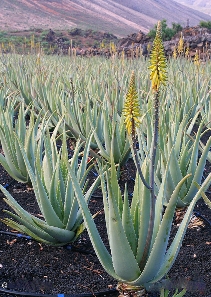| |
| |
Aloe Vera
(Aloe Barbadensis)
 |
Aloe Vera looks like a cactus, but is in fact a
member of the Lily family. Naturally found in tropical climates it has been
used by humans for 1000's of years.
A plant of many surprises, it is best known as an
addition to many cosmetic or skin care products. However, its uses are legion
and this curious plant with its spiky leaves is truly extraordinary.
HIGH ALTITUDE
ORGANICS™ products we use pure 100% stabilised aloe vera gel from the inner
leaf as the primary ingredient, not just a splash!
A new Human Study finds that Aloe vera enhances
bioavailability of vitamins B12 and C and ORAC among mature adults.
The UC Davis study
was presented at the Experimental Biology Convention in Washington DC in
April of this year and has renewed dialogue about Aloe within the natural
products community.
How does it
work?
Its natural anti-inflammatory and anti-microbial
action, combined within its nutritional constituents, promote cell growth, and
therefore healing. However, it is not only helpful for people with problems;
most people taking it report a greater sense of well being - they just feel
'better' or they report feeling calmer and less anxious. This could be due to
aloe's effect on their immune system which, you may say, becomes balanced or
fine-tuned, and therefore, more efficient at defending the body from
attack.
Stabilized Aloe Vera Gel (when taken as a drink or
applied externally to the skin and hair) has the following benefits:
It is a natural
cleanser due to the presence of saponins.
It penetrates tissue
due to its lignin content.
It anaesthetises the tissue in the area to which it is
applied, relieving pain deep beneath the surface, including pain associated with
joints and sore muscles.
It is bactericidal when held in high concentration for
several hours in direct contact with bacteria, whereas antibiotics kill bacteria
when highly diluted.
It is viruscidal and fungicidal when in direct contact
in high concentration for a long period of time.
It is
anti-inflammatory. It acts like a steroid, but with no side effects.
It is anti-pruritic -
reducing itching and burning. It is a natural moisturizer, taking moisture to
all layers of the skin.
It stimulates cell replication.
The proteolytic
enzymes break down dead tissue - cleansing a wound (topical products).
It helps to
increase blood flow in the skin by capillary dilation.
It is health giving to
the skin and body by providing a wide range of vitamins,
minerals, sugars,
enzymes and amino acids, essential and secondary.
Aloe Vera is a cactus
like plant but belongs to onion, lilly and garlic family. You may call it as
GHEE KANWAR, KUMARI or KORPHAD etc. There are over 300 known varieties of
Aloe Vera but only 5 contain medicinal properties. The most potent is
BARBADENSIS MILLER. The benefits have been recorded in many civilization
including those of Egypt, Persia, Greece, Italy, Africa and India etc. From
the time of Cleopatra to recent Mahatma Gandhi, all knew the goodness of Aloe
Vera and call it as silent healer.
KNOWN CONSTITUENTS OF ALOE VERA AND THEIR
PROPERTIES
Aloe Vera is a cactus like plant but belongs to
onion, lilly and garlic family. You may call it as GHEE KANWAR, KUMARI or
KORPHAD etc. There are over 300 known varieties of Aloe Vera but only 5
contain medicinal properties. The most potent is BARBADENSIS MILLER. The
benefits have been recorded in many civilization including those of Egypt,
Persia, Greece, Italy, Africa and India etc. From the time of Cleopatra to
recent Mahatma Gandhi, all knew the goodness of Aloe Vera and call it as
silent healer.
KNOWN CONSTITUENTS OF ALOE VERA AND THEIR
PROPERTIES
LIGNIN: Lignin is a cellulose-based substance which
has penetrating ability and acts as carrier for other nutrients and components
and also provides provides deeper penetration.
SAPONINS: Saponins is
a soap like substance which helps in cleansing of body tissues and it is
also antiseptic.
VITAMINS: Vitamin A, B1, B2, B3, B5, B6, C, D, E,
Chlorine & Folic acid. Vitamin A, C, & E are antioxidants that help to
neutralize free radicals. B complexes and choline are involved in metabolism
of amino acids. B12 and folic acid are needed for production and development
of red blood cells.
MINERALS: Calcium, Chromium, Copper, Iron,
Magnesium, Manganese, Potassium, Phosphorus, Sodium, and Zinc, these are
required for food health, stronger bones and teeth.
AMINO ACIDS: Provides
20 of the 22 types including 7 types of essential amino acids. Amino acids are
needed for production of body cells and tissues.
ANTHRAQUINONES:
Provides 12 Anthraquinones which are known as laxatives. Together with gel
they provide Anti-bacterial, Anti-viral, Anti-Fungal and Analgetic
activity.
ENZYMES:Provides 9 enzymes which help breakdown of
food sugar and fats, aiding and enhancing nutrient absorption.
POLYSACCHARIDES: They
are believed to be helpful in stimulating production of antibodies and white
blood cells.
ALOE VERA helps to improve conditions of people with
DIGESTIVE DISORDERS, ARTHRITIS RHEUMATISM, MUSCULAR PROBLEMS, BODY PAINS,
MENSTRUAL PROBLEMS, LIVER/KIDNEY AILMENTS, HIGH BLOOD PRESSURE, STRESS,
BRONCHITIS, SINUSITIS, DIABETES, ULCERS, SLEEPLESSNESS, LACK OF ENERGY,
ASTHMA, HEMORRHOIDS, COLITIS, GOUT, CANCER, HEART DISEASES, CHOLESTEROL,
OSTEOPOROSIS, CONSTIPATION, DIARRHEA, URINARY TRACT INFECTION, ECZEMA,
PSORIASIS, SHINGLES, ACNE, RASHES, SCARS, WARTS, LUPUS AND ALCOHOLISM
The physical and chemical properties of Aloe
Vera
The
aloe plant is between 99 and 99.5 per cent water, with an average pH of 4.5.
The remaining solid material contains over 75 different ingredients including
vitamins, minerals, enzymes, sugars, anthraquinones or phenolic compounds,
lignin, saponins, sterols, amino acids and salicylic acid. These are described
in more detail below.
Vitamins - The plant contains many vitamins, excluding
vitamin D but including the important antioxidant vitamins A, C and F. Vitamins
B (thiamine), niacin, vitamin B2 (riboflavin), choline and folic acid are also
present. Some authorities suggest that there is also a trace of vitamin B12
(Coats1979).
Enzymes - When taken orally, several of these
biochemical catalysts, such as amylase and lipase, can aid digestion by breaking
down fats and sugars. One important enzyme, a carboxy-peptidase, inactivates
bradykinins and produces an anti-inflammatory effect. During the inflammatory
process, bradykinin produces pain associated with vasodilation and, therefore,
its hydrolysis reduces these two components and produces an analgesic effect
(Obata et al 1993, Shelton 1991).
Minerals - Sodium, potassium, calcium, magnesium,
manganese, copper, zinc, chromium and iron are all found in the aloe plant.
Magnesium lactate inhibits histidine decarboxylase and prevents the formation of
histamine from the amino acid, histadine (Shelton 1991). Histamine is released
in many allergic reactions and causes intense itching and pain. The prevention
of its formation may explain the antipuritic effect of aloe vera.
Sugars : Sugars are
derived from the mucilage layer of the plant under the rind, surrounding the
inner parenchyma or gel. They form 25 per cent of the solid fraction and
comprise both mono- and poly-saccharides. By far the most important are the long
chain polysaccharides, comprising glucose and mannose, known as the
gluco-mannans (Beta - (1, 4) - linked acetylated mannan). When taken orally,
some of these bind to receptor sites that line the gut and form a barrier,
possibly helping to prevent ‘leaky gut syndrome’. Others are ingested whole by a
method of cellular absorption known as pinocytosis. Unlike other sugars which
are broken down prior to absorption, the polysaccharides are absorbed complete
and appear in the blood stream unchanged. Here, they act as immuno-modulators
capable of enhancing and retarding the immune response (Green 1996, Kahlon et al
1991, Sheets et al ).
Anthraquinones : These phenolic compounds are found in
the sap. The bitter aloes consist of free anthraquinones and their
derivatives:
Barbaloin-lO- (1151 -anhydroglucosyl)
-aloe-emodin-9-anthrone) lsobarbaloinAnthrone-C-glycosides and
chromones.
In large amounts these compounds exert a powerful
purgative effect, but when smaller they appear to aid absorption from the gut,
are potent antimicrobial agents (Lorenzetti et all 964, Sims eta/i 971 a), and
possess powerful analgesic effects. Topically, they can absorb ultra violet
light, inhibit tyronase activity, reduce the formation of melanin and any
tendency to hyper-pigmentation (McKeown 1987, Strickland eta/i 993). Lignin
This woody substance, inert in itself, endows topical aloe preparations with
their singular penetrative ability to carry other active ingredients deep into
the skin to nourish the dermis (Coats 1979).
Saponins : These soapy
substances form 3 per cent of the gel and are general cleansers, having
antiseptic properties (Hirat and Suga 1983).
PlantSterols : These
include Campesterol, f3 Sitosterol and Lupeol (Coats 1979).
Sallcylic acid : This
is an aspirin-like compound possessing anti-inflammatory and antibacterial
properties. Topically, it has a kerolytic effect which helps to debride a wound
of necrotic tissue.
Amino acids : These are the building blocks of
proteins. Aloe vera gel provides 20 of the 22 necessary amino acids required by
the human body and seven of the eight essential amino acids which the body
cannot synthesise. These must be ingested in food.
Aloe vera oil is made
from the maceration of the aloe vera plant and infused with a base oil, such as
soybean, almond or apricot, resulting in an aloe vera oil extract. The
botanical classification is of the family "aloceae," and the genus "aloe
vera."
The oil extracted from Aloe Vera plant is believed to
be a great skin rejuvenator. It ensures speedy recovery of wounds and is also
quite effective in treating sunburns. In addition, it is very beneficial in
curing Arthritis. Aloe Vera is known to possess anti inflammatory properties. It
also serves as a wonderful moisturizer. It is able to penetrate quickly and
deeply into the skin and therefore is a popular choice amongst the base oils for
use in Aromatherapy. For body scars and stretch marks, Aloe Vera oil truly works
wonders. Aloe Vera oil provides innumerable health benefits for which it is
preferred the most.
Disclaimer: The
information presented herein is intended for educational purposes only. These
statements have not been evaluated by the FDA and are not intended to diagnose,
cure, treat or prevent disease. Individual results may vary, and before using
any supplements, it is always advisable to consult with your own health care
provider. |
|
|


















